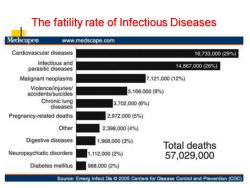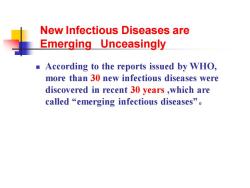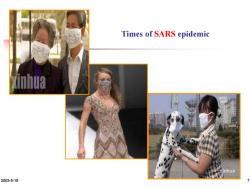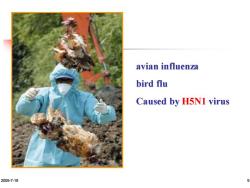《传染病学》课程教学资源(PPT课件)General Principles of Infectious Diseases(总论)

General Principles of Infectious Diseases Yuan Zhe MD Dept of Infectious Diseases
General Principles of Infectious Diseases Yuan Zhe MD Dept of Infectious Diseases

The fatility rate of Infectious Diseases Medscape www.medscape.com Cardiovascular diseases 16,733,000(29%) Infectious and parasitic diseases 14,867,000(26%) Malignant neoplasms 7.121,000(12%) Violence/injuries/ accidents/suicides 5,168,000(9%) Chronic lung 3,702,000(6%) diseases Pregnancy-related deaths 2,972.000(5%) Other 2,398.000(4%) Digestive diseases 1968,000(3%) Total deaths Neuropsychiatic disorders 1.112,000(2%) 57,029,000 Diabetes mellitus 988.000(2) Source:Emerg Infect Dis2005 Centers for Disease Control and Prevention(CDC)
The fatility rate of Infectious Diseases

Main communicable diseases The first 10 communicable diseases,2003 Incidence Rate Mortality Rate Fatality Rate Sequence (1/100000) (1/100000) (%) Viral Hepatitis 68.55 Newborn Tetanus 0.30 Hydrophobia 97.20 Pulmonary 2 52.36 Hydrophobia 0.15 Diphtheria 33.33 Tuberculosis Pulmonary 3 Dysentery 34.52 0.08 AIDS 33.10 Tuberculosis Gonorrhea 14.09 Viral Hepatitis 0.08 Newborn Tetanus 14.51 5 Measles 5.55 AIDS 0.03 Plague 7.69 6 Syphilis 4.50 Encephalitis B 0.03 SARS 6.61 Typhoid 7 4.17 SARS 0.03 Epidemic Encephalitis 5.48 Paratyphoid Fever 8 Malaria 3.00 Dysentery 0.02 Encephalitis B 4.66 9 Newborn Tetanus 2.03 Hemorrhage Fever 0.01 Leptospirosis 3.33 Hemorrhage Epidemic 10 1.68 0.01 Anthrax 1.66 Fever Encephalitis
The first 10 communicable diseases, 2003 Main communicable diseases

Re-emergence of Classical Infectious Diseases Tuberculosis Viral hepatitis Sexually transmitted diseases
Re-emergence of Classical Infectious Diseases ◼ Tuberculosis ◼ Viral hepatitis ◼ Sexually transmitted diseases

New Infectious Diseases are Emerging Unceasingly According to the reports issued by WHO, more than 30 new infectious diseases were discovered in recent 30 years which are called“emerging infectious diseases
New Infectious Diseases are Emerging Unceasingly ◼ According to the reports issued by WHO, more than 30 new infectious diseases were discovered in recent 30 years ,which are called “emerging infectious diseases

Major etiologic agents and infectious diseases identified since 1980's 1982 Escherichia Coli 0157:H7 ◆ 1982 Prion ■ 1983 HIV AIDS ◆ 1988 Hepatitis E virus ■ 1989 Hepatitis C virus ◆ 1992 Vibrio cholerae 0139 1994 Sabia virus ◆ 1995 Human herpes virus-8 ■ 1997 H5N1 virus (Avian influenza virus) 2003 SARS Virus(severe acute respiratory syndrome,SARS) 2005 Streptococcus suis
Major etiologic agents and infectious diseases identified since 1980’s ▪ 1982 Escherichia Coli O157:H7 ▪ 1982 Prion ▪ 1983 HIV AIDS ▪ 1988 Hepatitis E virus ▪ 1989 Hepatitis C virus ▪ 1992 Vibrio cholerae O139 ▪ 1994 Sabia virus ▪ 1995 Human herpes virus-8 ▪ 1997 H5N1 virus (Avian influenza virus) ▪ 2003 SARS Virus (severe acute respiratory syndrome, SARS) ▪ 2005 Streptococcus suis

Times of SARS epidemic nhua 2003-5-19 7
2003-5-19 7 Times of SARS epidemic

SARS:Number of Current Probable Cases as of 24 May 2003,19:00 GMT+2 hina:2326 Chino.Toiwon:396 Chino.Hong Kong SAR:196 Thailand:1 Chino,Macoo SAR:2 Singopore:12 Number of current probable cases 1 藏50.500 >500 Data Source:World Health Organization Map Production:Public Heakh Mapping Tear D)

avian influenza bird flu Caused by H5N1 virus 2005-7-19 9
2005-7-19 9 avian influenza bird flu Caused by H5N1 virus

Outline Infection and Immunity 2. Pathogenesis of Infectious Diseases 3. Epidemic Process and The effect Factors 4.Features of Infectious Disease 5.Diagnosis of Infectious Diseases 1.Treatment of Infectious Diseases 2. Control of Infectious Diseases
Outline 1. Infection and Immunity 2. Pathogenesis of Infectious Diseases 3. Epidemic Process and The effect Factors 4. Features of Infectious Disease 5. Diagnosis of Infectious Diseases 1. Treatment of Infectious Diseases 2. Control of Infectious Diseases
按次数下载不扣除下载券;
注册用户24小时内重复下载只扣除一次;
顺序:VIP每日次数-->可用次数-->下载券;
- 《传染病学》课程教学资源(PPT课件)Epidemic Cerebrospinal Meningitis(流脑).ppt
- 《传染病学》课程教学资源(PPT课件)Cholera(霍乱).ppt
- 《传染病学》课程教学资源(PPT课件)Bacillary dysentery(菌痢).ppt
- 《传染病学》课程教学资源(PPT课件)AIDS(艾滋病).ppt
- 《传染病学》课程教学资源(PPT课件)严重急性呼吸综合征、人禽流感病、人猪链球菌(重庆医科大学:邹启园).ppt
- 《传染病学》课程教学资源(PPT课件)霍乱 Cholera(重庆医科大学:朱卫民).ppt
- 《传染病学》课程教学资源(PPT课件)败血症 septicemia.ppt
- 《传染病学》课程教学资源(PPT课件)病毒性肝炎 viral hepatitis(重庆医科大学:卢萍).ppt
- 《传染病学》课程教学资源(PPT课件)流行性脑脊髓膜炎 meningococcal meningitis.ppt
- 《传染病学》课程教学资源(PPT课件)传染病总论(重庆医科大学:袁喆).ppt
- 《传染病学》课程教学资源(PPT课件)伤寒与副伤寒 Typhoid Fever and Paratyphoid Fever.ppt
- 《传染病学》课程教学资源(PPT课件)艾滋病 Acquired Immune deficiency Syndrome.ppt
- 《传染病学》课程教学资源(PPT课件)流行性出血热.ppt
- 《传染病学》课程教学资源(PPT课件)人禽流感 human avian influenza(重庆医科大学:邓蕙).ppt
- 《传染病学》课程教学资源(PPT课件)严重急性呼吸综合征(severe acute respiratory syndrome, SARS).ppt
- 《传染病学》课程教学资源(作业习题)艾滋病(含参考答案).doc
- 《传染病学》课程教学资源(作业习题)课后习题(含参考答案).doc
- 《传染病学》课程教学资源(作业习题)霍乱(含参考答案).doc
- 《传染病学》课程教学资源(作业习题)流行性乙型脑炎(含参考答案).doc
- 《传染病学》课程教学资源(作业习题)伤寒、副伤寒(含参考答案).doc
- 《传染病学》课程教学资源(PPT课件)Malaria(疟疾).ppt
- 《传染病学》课程教学资源(PPT课件)Typhoid Fever and Paratyphoid Fever(伤寒与副伤寒).ppt
- 《传染病学》课程教学资源(PPT课件)Viral Hepatitis(肝炎).ppt
- 重庆医科大学:《传染病学》课程教学大纲(供5年制及7年制使用).doc
- 重庆医科大学:《传染病学》课程教学大纲.doc
- 重庆医科大学:《传染病学》课程教学资源(教案讲义)出血热.doc
- 重庆医科大学:《传染病学》课程教学资源(教案讲义)钩端螺旋体病.doc
- 重庆医科大学:《传染病学》课程教学资源(教案讲义)败血症.doc
- 重庆医科大学:《传染病学》课程教学资源(教案讲义)伤寒.doc
- 重庆医科大学:《传染病学》课程教学资源(教案讲义)病毒性肝炎.doc
- 重庆医科大学:《传染病学》课程教学资源(教案讲义)总论.doc
- 重庆医科大学:《传染病学》课程教学资源(教案讲义)阿米巴肝脓肿.doc
- 重庆医科大学:《传染病学》课程教学课件(PPT讲稿)伤寒(感染病科:石小枫).ppt
- 重庆医科大学:《传染病学》课程教学课件(PPT讲稿)败血症 septicemia.ppt
- 重庆医科大学:《传染病学》课程教学课件(PPT讲稿)钩端螺旋体病 Leptospirosis.ppt
- 重庆医科大学:《传染病学》课程教学课件(PPT讲稿)传染病总论(主讲:赵有蓉).ppt
- 重庆医科大学:《传染病学》课程教学课件(PPT讲稿)流行性出血热 epidemic hemorrhagic fever(EHF)hemorrhagic fever with renal syndrome(HFRS).ppt
- 重庆医科大学:《传染病学》课程教学课件(PPT讲稿)阿米巴肝脓肿 amebic liver abscess.ppt
- 重庆医科大学:《传染病学》课程教学课件(PPT讲稿)病毒性肝炎 Viral Hepatitis(主讲:张大志).ppt
- 重庆医科大学:《儿童保健学》课程教学大纲(供临床医学五年制儿科方向使用).doc
